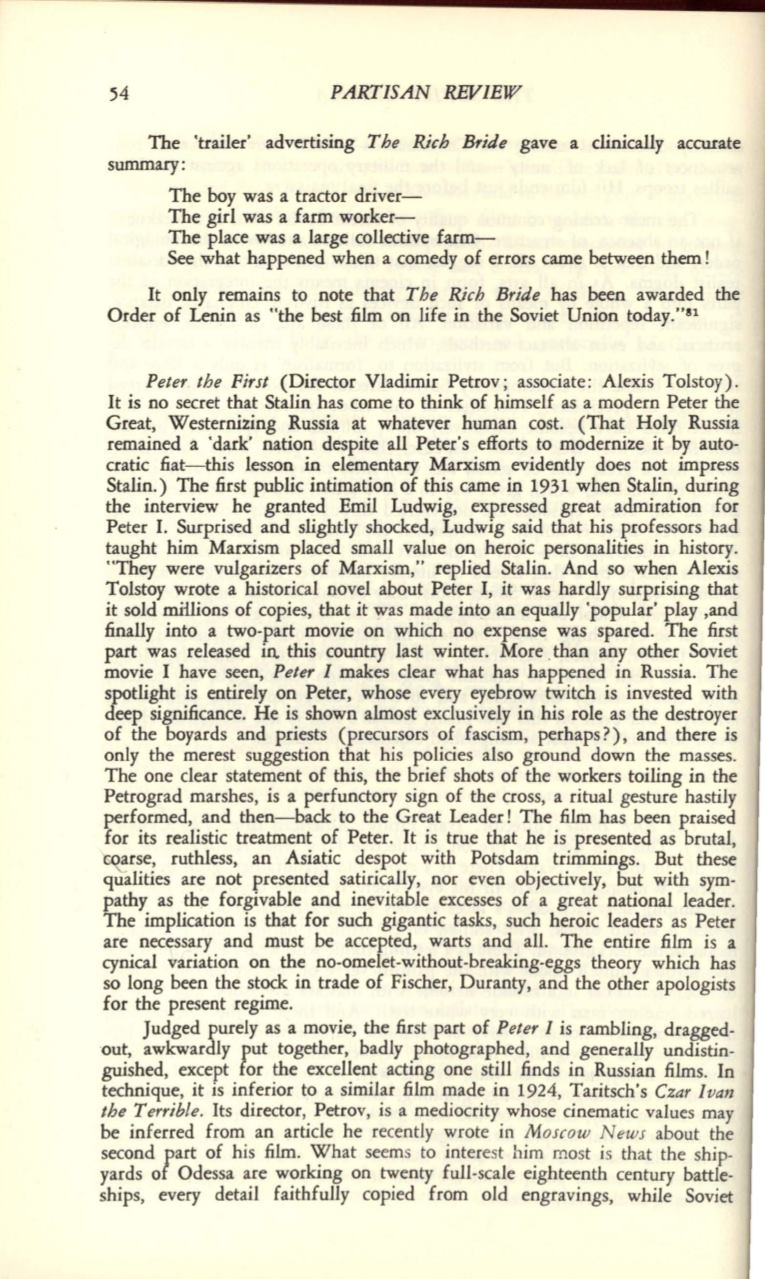
54
PARTISAN REVIEW
The 'trailer' advertising
The Rich Bride
gave a clinically accurate
summary:
The
boy
was a tractor driver–
The girl was a farm worker-
The place was a large collective farm-
See what happened when a comedy of errors came between them!
It
only remains to note that
The Rich Bride
has been awarded the
Order of Lenin as "the best film on life in the Soviet Union today."S1
Peter the First
(Director Vladimir Petrov; associate: Alexis Tolstoy).
It
is no secret that Stalin has come to think of himself as a modern Peter the
Great, Westernizing Russia at whatever human cost. (That Holy Russia
remained a 'dark' nation despite all Peter's efforts to modernize it by auto–
cratic fiat-this lesson in elementary Marxism evidently does not impress
Stalin.) The first public intimation of this came in 1931 when Stalin, during
the interview he granted Emil Ludwig, expressed great admiration for
Peter
I.
Surprised and slightly shocked, Ludwig said that his professors had
taught him Marxism placed small value on heroic personalities in history.
"They were vulgarizers of Marxism," replied Stalin. And so when Alexis
Tolstoy wrote a historical novel about Peter I, it was hardly surprising that
it sold miilions of copies, that it was made into an equally 'popular' play ,and
finally into a two-part movie on which no expense was spared. The first
part was released in. this country last winter. More ,than any other Soviet
movie I have seen,
Peter I
makes clear what has happened in Russia. The
spotlight is entirely on Peter, whose every eyebrow twitch is invested with
deep significance. He is shown almost exclusively in his role as the destroyer
of the boyards and priests (precursors of fascism, perhaps?), and there is
only the merest suggestion that his policies also ground down the masses.
The one clear statement of this, the brief shots of the workers toiling in the
Petrograd marshes, is a perfunctory sign of the cross, a ritual gesture hastily
performed, and then-back to the Great Leader! The film has been praised
for its realistic treatment of Peter.
It
is true that he is presented as brutal,
~rse,
ruthless, an Asiatic despot with Potsdam trimmings. But these
qualities are not presented satirically, nor even objectively, but with sym–
pathy as the forgivable and inevitable excesses of a great national leader.
The implication is that for such gigantic tasks, such heroic leaders as Peter
are necessary and must be accepted, warts and all. The entire film is a
cynical variation on the no-omelet-without-breaking-eggs theory which has
so long been the stock in trade of Fischer, Duranty, and the other apologists
for the present regime.
Judged purely as a movie, the first part of
Peter I
is rambling, dragged–
out, awkwardly put together, badly photographed, and generally undistin–
guished, except for the excellent acting one still finds in Russian films. In
technique, it is inferior to a similar film made in 1924, Taritsch's
Czar Ivan
the Terrible.
Its director, Petrov, is a mediocrity whose cinematic values may
be inferred from an article he recently wrote in
Moscow News
about the
second rart of his film. What seems to interest him most is that the ship–
yards
0
Odessa are working on twenty full-scale eighteenth century battle–
ships, every detail faithfully copied from old engravings, while Soviet


